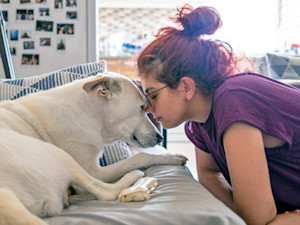The Cure for Your Anxiety Could Be Watching More Dog Videos, New Study Says
Sometimes your phone can actually help.
We could all use some stress release — anyone who has read the news in the past, er, 5,000 or so days would agree. Dog lovers probably already know that when anxiety’s creeping up, turning to a pet — especially a trained therapy dog — is a fool-proof way to get some comfort. But our pups aren’t always nearby, and not everyone’s able to access a therapy dog or adopt a pet of their own. Luckily, those puppy superpowers extend into cyberspace. A new studyopens in new tab found that therapy dog videos can be nearly as effective at reducing anxiety as an in-person interaction (nothing can ever fully beat those IRL snuggles, after all).
The study
Plenty of studies have already proven that therapy dogs are effective at reducing stress for everyone from students studying for a test to people living with PTSD to kids receiving emergency medical care. When it comes to human therapists, plenty of people already visit their provider virtually or utilize online resources like meditation apps. Researchers wanted to discover if a virtual substitution for canine therapy could be similarly useful.
Trick question: All dogs are perfect! But find out which type is the best fit for you.
They had 1,000 participants — both students and non-students — rate their stress on a five-point scale before and after watching a brief pre-recorded video of a therapy dog. The video included a welcome by the dog’s handler, a land acknowledgment, and an introduction to the program. The dog’s handlers then asked participants meditative, thought-provoking questions, such as asking them to reflect on their wellbeing, just as handlers typically do during in-person therapy dog visits. They also described their dog’s fur, explained how the dog likes to be pet, and asked participants to imagine themselves petting the dog.
The results
Both students and non-students reported significantly lower stress after the session. Student stress dropped from 3.33 to 2.53 on a five-point scale, and non-student stress dropped from 3.07 to 2.43. There were no significant differences across age groups, but women were more calmed by the sessions than men; women had a higher beginning stress level, and a similar ending stress level.
How much do you spend on your pet per year?
The findings could have positive implications for many people who may not have access to an in-person dog or a trained therapy dog — including those who may avoid therapy altogether. “I have thought about attending an in-person session on campus before since I love dogs but the interacting with humans made me anxious,” one student shared during the studyopens in new tab. “No offense to anyone but this virtual dog session removes the unknown human interaction that may make people nervous.”
The length of the sessions is notable, too — the videos were only five minutes long, yet they significantly improved the participants’ emotional states. A quick break with a dog video during a long workday could do wonders for emotional wellbeing.
Researchers are hopeful that the ease of these sessions can break down barriers to mental health. “We believe that our virtual canine comfort modules hold the potential to increase access to key well-being resources,” Christine Y. Tardif-Williams, the study’s lead author, wrote. “Virtual [canine-assisted intervention] can offer non-threatening, easily accessible, and cost-effective well-being support to a diverse audience of people.”







